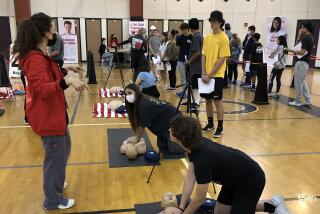New CPR guidelines say bystanders can skip mouth-to-mouth
- Share via
For those of you inclined to administer CPR to someone in need, but put off by the idea of mouth-to-mouth resuscitation, here’s more affirmation that you can can help with chest compressions alone:
- The American Heart Assn.’s new guidelines, released Monday, say that laypeople should be encouraged to do “Hands-Only CPR.”
- A study published online Friday in Lancet concludes that patients treated with chest compressions alone were more likely to survive than patients who received standard cardiopulmonary resuscitation.
The new AHA guidelines say that when you encounter someone in sudden cardiac arrest, the first thing anyone -- professional or layperson -- should do is begin chest compressions to get the oxygen that’s still in the lungs circulating throughout the body right away, especially to the heart and brain. Those compressions should also be delivered more quickly then previously recommended -- at least 100 times a minute.
People who are trained in more advanced life support can follow up those compressions by checking the victim’s airway, then pinching his nose and breathing into his mouth. As a result, the old ABCs of CPR -- airway, breathing, compressions -- should now be CAB.
The changes apply to adults, children and infants, but not newborns, the AHA said.
In the Lancet study, researchers pooled the results of three randomized trials that compared the efficacy of standard CPR and chest-compression-only CPR when administered by bystanders outside of a hospital setting. They found that 14% of patients treated with chest compressions survived, compared with 12% of patients who got traditional CPR.
The researchers also looked at seven observational studies comparing both resuscitation methods and found that patients were just as likely to survive whether they got mouth-to-mouth or not; in either case, 8% of patients were revived.
Studies began showing the benefit (or at least the lack of inferiority) of chest-compression-only CPR way back in 2007. The AHA responded in 2008 with a recommendation that laypeople could do only two things: call 911 and administer chest compressions.
-- Karen Kaplan / Los Angeles Times





